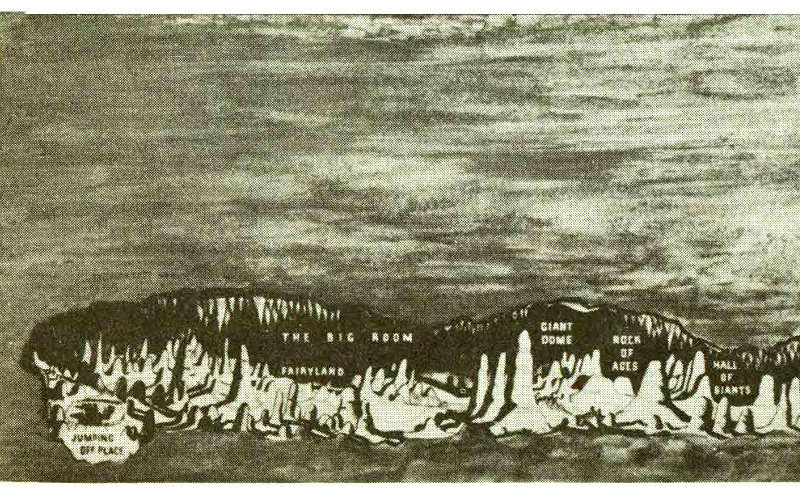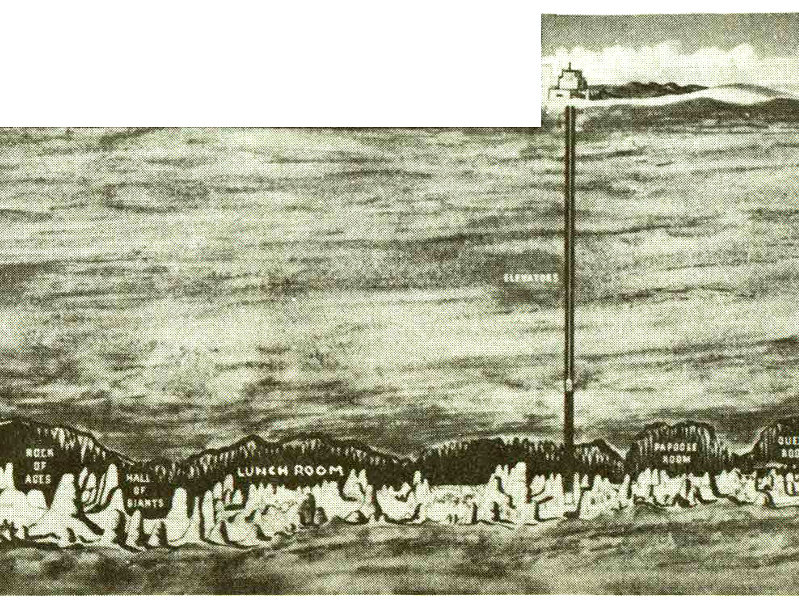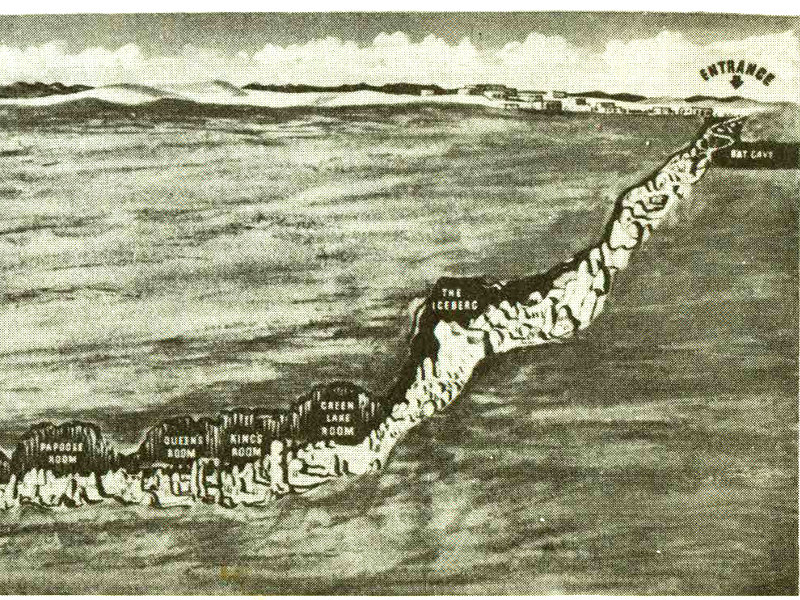
Title: Carlsbad Caverns National Park, New Mexico
Author: Jim White
Release date: September 14, 2015 [eBook #49970]
Most recently updated: October 24, 2024
Language: English
Credits: Produced by Stephen Hutcheson, Dave Morgan and the Online
Distributed Proofreading Team at http://www.pgdp.net

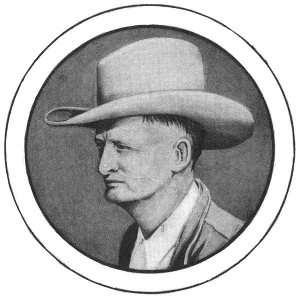
Born—July 11, 1882 Died—April 28, 1946
COPYRIGHT MCMLI BY CHARLIE L. WHITE & JIM WHITE, JR.
GENUINE·CURTEICH·CHICAGO C. T. PHOTO-PLATING CREATION

Bats!... millions of black little mammals drifting along the horizon and seeming to fuse into the hazy clouds of a New Mexico sunset! That was the spectacle which led Jim White, back at the turn of the century, to become interested in the colossal phenomenon designated by Act of Congress as Carlsbad Caverns National Park.
If you could ask him about it today, Jim’s eyes would probably turn inward as he’d muse and remember. “I thought it was a volcano—but then I’d never seen one. For that matter, I’d never seen bats fly. I had seen plenty of prairie whirlwinds during my life on the range, but this thing didn’t move. It seemed to stay in one spot near the ground—but the top kept spinning upward. I watched maybe a half-an-hour, and being about as curious as the next fellow, I started toward the place”.
Jim White, native of Mason County, Texas, grew up ranching ... surrounded by the cattle-business, without even a grammar school education. Jim would have preferred bustin’ broncos to books and blackboards even if there had been a little log schoolhouse on his native soil. So it was an experienced ten-year-old range-rider who teamed up with John and Dan Lucas of the X-X-X Ranch in New Mexico, three miles or so from the entrance to the cave. Jim White spent eight or ten years on the range surrounding Lucas’ Ranchhouse, and like the other rangemen, had known of “the bat cave”, but he had felt no impelling urge to see what was hiding in its darkness.
Then came the day of the bat-flight. Crawling through the rocks and brush, Jim White approached the spot from which the bats seemed literally to boil. The incredulous young range-rider made a feeble guess about the number of bats—could think no further than millions—but realized that any hole with capacity for that many bats must be a whale of a big affair. Creeping still closer, Jim finally lay on the brink of the chasm and looked down ... into awesome, impenetrable blackness.
Torn between awe and curiosity, Jim did the natural thing for a man familiar with desert ranges.
“I piled up some dead cactus and built a bonfire. When it was burning good, I took a flaming stalk and pushed it off into the hole. Down, down, down it went until the flame went out—and I still watched until the embers sprinkled on the rocks below. Seemed the thing wouldn’t ever stop, but later it measured about thirty or forty feet from where I dropped the fire down to that faraway bottom. I kicked the remainder of the fire into the hole and watched 2 it fall. The bats seemed to be scared, and for several minutes none flew out. Soon as the embers died, though, they boiled up again. I watched another hour or so, then went back to camp.”

750 Feet Underground, the Temple of the Sun in the Big Room
The fence-building crew, camped in the vicinity at the time, heard not a word from their companion about his observation.
Jim White kept his counsel, waited a couple of days for the opportunity, then gathered together several coils of rope, a kerosene lantern, some wire and a hand-axe.
“I got back to the cave about mid-afternoon. You know the opening faces West, and the sun was in the right place to shine down into it. There was enough light so I could see the bottom of the shaft. Off to the right I could see the opening of a huge tunnel, and my imagination started running ahead of me. Where would that tunnel lead? I made up my mind to find out.”
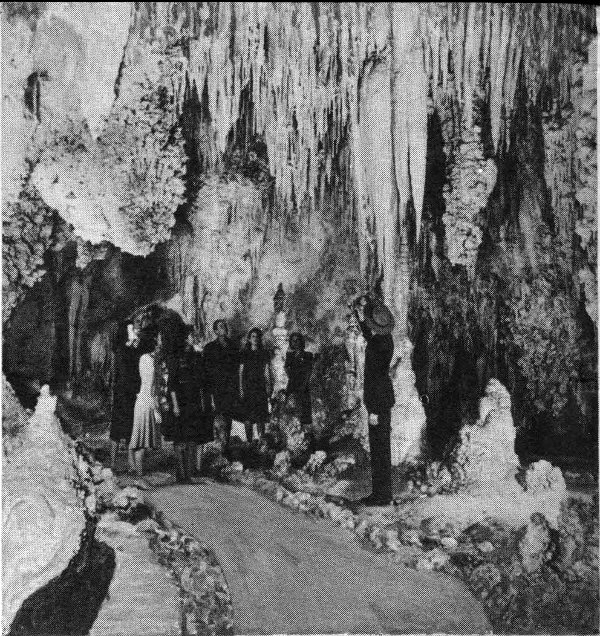
Dazzling White Beauty in the King’s Palace
Busy with the hand-axe, Jim cut sticks of wood from the shrubs nearby, accumulating a sizeable pile. Next, he picked up the rope and the wire ... and with his newly-cut sticks for steps, Jim White’s rope-ladder-to-adventure was soon lowered into the entrance of the cave. Cautious rung-by-rung descent led the probing cowboy down into blackness until his feet touched something solid. Lighting his lantern, he discovered himself on a narrow ledge—almost at the end of his rope, literally and figuratively!
From that precarious spot, Jim could see into the tunnel—only a little farther and he could be on its smooth-looking floor level. Appetite whetted for exploration, the range-toughened man dared a “human-fly” approach, holding onto the rough wall for that final twenty feet or so to wide, level footing!
Standing at the entrance to the tunnel, Jim peered ahead by light from his lantern ... a sickly glow against a blackness that seemed solid. Determined to see what was there, dark or no dark, the cowboy summoned his courage and started walking slowly forward.
“The tunnel grew larger with every step. It seemed to me that I was wandering into the very core of the Guadalupe Mountains.
“Finally, I reached a chamber—a whale of a big oval-shaped room. Looked like several hundred yards before there was a sharp curve to the right and another sharp descent. On the left was another big tunnel leading in the opposite direction ... and the floor on the left looked a little more smooth and level, so I tackled it first. It didn’t take long to discover that this one was the Bats’ Cave, so I went back to the big entrance and started down the other tunnel.
“I kept going until I found myself in the mightiest wilderness of strange formations a cowboy ever laid eyes on! It was the first cave I was ever in, and I didn’t know then that those formations had names like ‘stalagmites’. But I did know, with the kind of instinct the Creator puts into a man, that there just wasn’t another scene like this one in the whole world.”
To arrive at this point, Jim White had crept cat-like across a dozen dangerous ledges and past many a tremendous opening that seemed to reach downward into the very center of the earth. He dropped rocks to sound depths; into one opening he pushed a great boulder. It hit something—not bottom—and kept rolling and rolling until the sound faded into a haunting memory of sound.
“I walked through more of those ‘stalagmites’, and each one seemed larger and more beautifully formed than the ones I’d already seen. I blinked at the sight of giant-size wonders that turned out to be gleaming ‘onyx’. The ceilings blinked back at me with clusters of ‘stalactites’ ... like great chandeliers. The walls sparkled and glittered.”
Those walls were frozen cascades of flowstone, with jutting rocks holding long, slender formations that rang under Jim White’s experimental touch like keys on a xylophone. Floors were carpeted with formations with new shapes and new sizes at every turn. Through the gloom, Jim saw the tall, graceful, ghost-like shapes resembling totem-poles, stretching upward into darkness. Through crystal-clear water, Jim White saw that the sides of several pools at his feet were lined with what appeared to be marble. Lost in the beauty, the weirdness, the grandeur into which his inquisitive mind had led him, Jim forgot time, place and distance.
Suddenly, the oil in his lantern was exhausted. The flame curled and died. Reality descended swiftly, as if millions of tons of black wool drifted down to smother and choke. With the black loneliness paralyzing his bloodstream, Jim White tried to refill his lantern from the small emergency canteen of oil, brought for just such a moment.
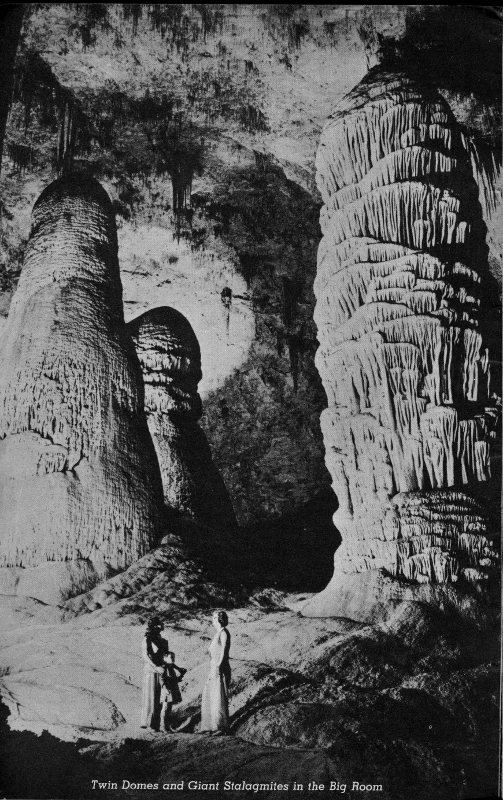
Twin Domes and Giant Stalagmites in the Big Room
“My fingers shook so much that I fumbled the filler-cap and spilled more oil in my lap than I did in my lamp. Then I dropped the filler-cap when I tried to screw it back on.
“The inky blackness and the almost ‘deafening’ total silence, save for an occasional drop, drop, drop of water, didn’ help me stop shaking, either. It’s hard to describe how completely dark, how perfectly still it is down in that cave. Seemed like a month went by before I got that lantern going again and looked around in the dim light to get my bearings.”
Foresight and range experience had prompted the westerner to leave landmarks for himself so the retracing of steps would be possible, even if natural sense of direction failed. Resourcefully using what was at hand, Jim’s guide-marks were broken stalactites taken from the floors and placed on top of the rocks, ends pointing to the outbound pathway. Even so, Jim started feeling a mounting fear that he might not be able to find the markers he had left behind. It was worse when he realized that no one at camp knew where he had gone—that his chances of being found were extremely remote even if his companions had known of his destination. In the cool depths of the cavern, now known to be 56 degrees day and night, summer and winter, the once-bold adventurer felt the wild alarm in his veins turn into perspiration and panic-chills.
“Suddenly I was seized with a mad desire to run—to charge like a crazy bull when he’s cornered. I scrambled along the edge of a black gash in the rock, and rammed my head against those sharp-pointed critters above me that all at once seemed unfriendly. Those needle-points pierced my hat and cut a few holes in my scalp ... and that sort of cooled me off. I leaned back against the wall and talked to myself the way a lonesome cowboy does. ‘Here, Jim’, I said, ‘don’t get in an uproar. It won’t get you anywhere. Take it easy’.”
Maybe those formations up there were not so unfriendly after all, because Jim seemed to hear his own words of advice returning from every direction. “Take it easy ... take it easy ... take it easy!”
Grasping the thin thread of courage which remained, the man who now feared that he would never see daylight again held the inadequate lantern securely in his hand. This was his last chance to reach the surface—the oil flickering away moment by moment in the little flame. Desperation was his strength, determination his guide as he held the lantern forward in search of those arrow-points to safety. Repeating the cat-crawl in reverse, narrowly clearing the margins of safety because nerves were jumpy and jangled, Jim White worked his agonizing way toward the tunnel’s mouth. The distance seemed multiplied by thousands of footsteps since he had traversed the distance ... when was it? Hours? Or days ago?
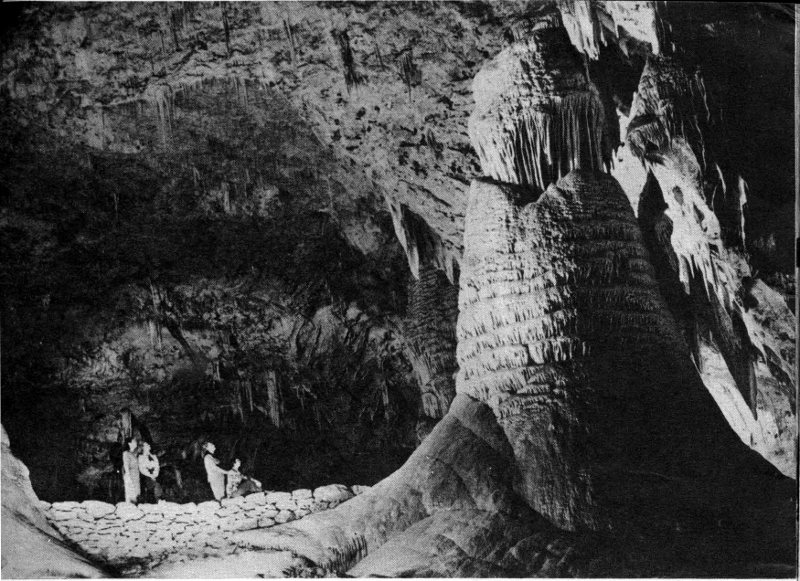
This Massive Growth has been forming for Centuries unknown and is one of the most Majestic Formations known
Never was there so gratifying a sight as the shaft of sunlight filtering down through the entrance. Fumbling, eager hands fastened onto the rope ladder and Jim White hungrily climbed over the rocky ledge to the warmth and cheer of the New Mexico sunshine.
“I waited a minute till my bones thawed out. Then I turned and stared back into the cave. It had beaten me—driven me out. I stared at it the way I’d stare at a stubborn bronco, telling myself that someday I would conquer it!”
Riding back to camp, busy with thoughts of the adventure and pondering about the possible extent of the cave, Jim White felt an increasing desire to see it all. He must see it, he felt, but wondered if it wouldn’t be better to get someone to go back with him. Somehow the mammoth, buried fairyland wouldn’t seem so overwhelming if someone else were along to relieve the silent, dark loneliness. The boys at camp, however, refused to take seriously Jim’s account of the bats and the glittering under-ground palace. The more he talked of it, the more they howled their disbelief.
“When they found out I was serious, they decided I had just naturally gone ‘plumb loco’, or else I’d set out to be the world’s champion cow-punchin’ liar! Try as I would, I couldn’t find a single cowboy who would agree to go with me. They just weren’t the least bit interested!”
At the Lucas X-X-X Ranch there was a Mexican boy about fifteen years old who worked steadily and said little. He couldn’t speak much English, and the cowboys were not gifted with much Spanish. Jim White never did know the boy’s real name or what became of him finally, but during those days called the young Mexican, as did the others, the “Kid”.
One day, the Kid called the exploring White aside and overcame language difficulties enough to offer his company on that risky trip into the cave! Jim accepted the offer readily enough! To return to the scene of his lonely adventure had by now become a consuming desire. Among Jim White’s acquaintances, if only “the Kid” would make the exploration with him, it was still a lot better than going alone.
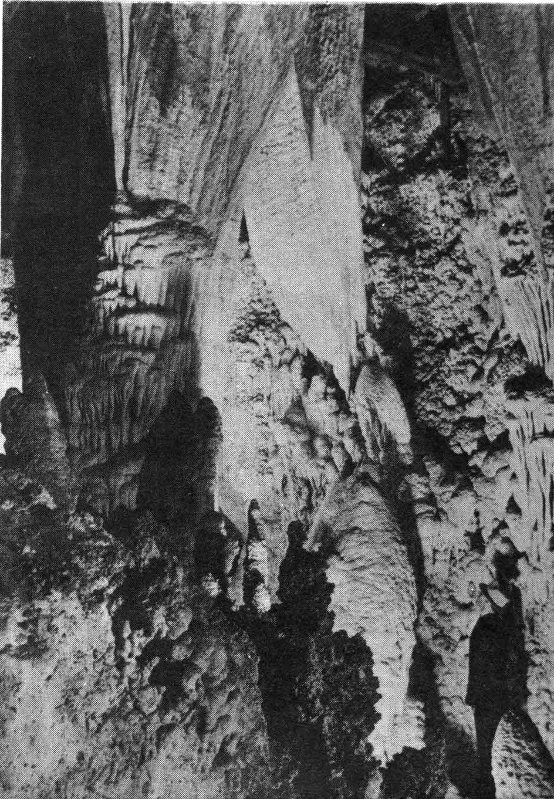
Elephant Ears in the Queen’s Chamber
Five days from his first trip into the cave, Jim White and the Kid set out with a couple of crude torches, a canteen of water, a sack of grub and a can of kerosene. Right up to the moment of departure, White expected his volunteer-companion to get cold feet and back out of the project, but at last they were headed together toward the Big Hole.
The kerosene torches were a great improvement over the lantern used in the first visit. The torches gave sufficient light to enable fairly good progress. Now familiar to the man, the startling, dazzling formations frightened the Kid, but as White expressed it: “He was a game little cuss, and never whimpered once. I doubt if any man could have stood up under the strain any better than the Kid”.
For three days, the strangely-matched pair roved and explored the recesses of the cave, covering about the same territory now open to visitors who take the guided tours. For Jim White and the Kid, however, there was not the comfortable element of bright lights—certainty—and sure-footed guides along well-established paths. Their three-day exploration was an unbroken chain of hazards and thrills, findings and fears, adventures which sound exaggerated even when evidence lends them support!
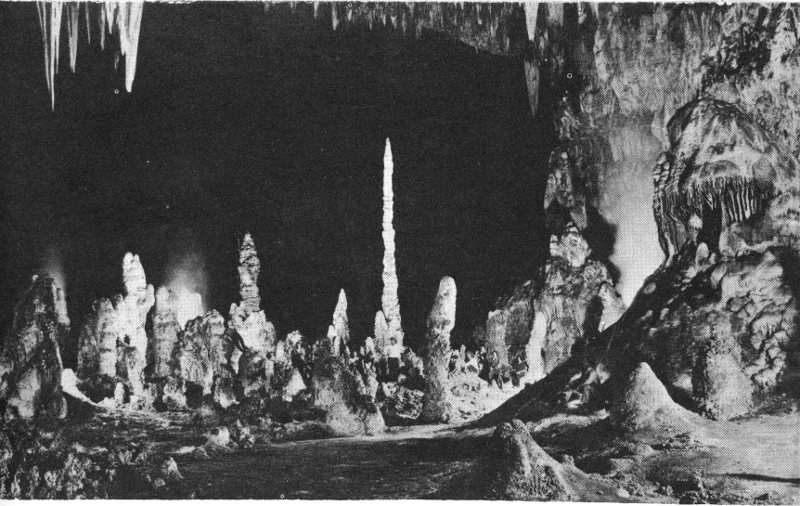
Towering Stalagmites from Floor of the Big Room, the Tallest one aptly called the Totem Pole
If you could ask Jim White about his biggest thrill during that unbelievable three-day experience, he would say: “During the last day, I was over in one corner of what we later called ‘The Big Room’, crawling along a ledge of rock. I sat down to rest and just looked around as I sat there. Over on the other side of the ledge, what do you suppose I saw? Staring right back at me was the skull of a man! Fast as I could I brought my torch about, and there was the whole skeleton intact. If I thought some giant could have been living in this cave along with the giant formations, right there seemed to be my proof! Those thigh-bones looked to me like the biggest kind of beef-shanks! I tried to pick up one of the leg-bones and it crumbled in my fingers. Just about that time a drop of water fell on my hand. Only the Good Lord knows how long that skeleton had been lying under that drip, but it must have been long 10 enough for the mineral water to soften the bones. It took just a touch to crumble the thigh, but the skull was not under the drip, so it was perfect. When I picked it up, the Kid backed away. I suggested that we’d take it back to camp with us, or the boys would never believe we found a skeleton in the cave.”
Jim White’s proposal brought a hesitant question from the Kid.
“How we take it?”
“Oh, we’ll put it in the bag with the grub”, Jim replied.
The groceries had been the Kid’s responsibility, till then. Firmly, immediately he told Jim White: “Then you carry it!” Jim did. Sometime later a doctor in Carlsbad borrowed the skull to examine it. Someone borrowed it from him, and that one in turn loaned it to someone else, until eventually all trace of it was lost ... a most unfortunate eventuality, since the skull would have been among the most treasured of the cave-souvenirs in Jim White’s collection.
Jim finally deduced that the skeleton was all that remained of some Indian who wandered into the cave out of curiosity, even as Jim himself had done. Failing to find the way out, the Indian must have starved there on the ledge. Cowboy White was often heard to muse that this Indian must have been an unusually brave Red Man, for it is known that Indians feared darkness and the unknown above all else. That might be the logical explanation for the fact that there was never found any trace of Indian habitation within the cavern, even though small groups lived in the vicinity. An Indian cooking-pit can still be seen near the cavern entrance, beside the present flagpole.
Other skeletons were found by Jim White, though none had the spectacular thrill for him engendered by that first sight of a frame-work of a man.
With all their excitement to feed their interest, Jim and his youthful companion might have stayed longer than three days, but for an untoward event which Jim would describe:
“I had the oil for our torches. It was in a gallon can ... the can in a gunny-sack slung over my shoulder. The can started leaking and my clothes were soaking up kerosene.... Before long my back was sore and burning, so I was planning to stop as soon as we got off the ledge we were crawling on at the time. Wanted to fix my back, the best I could in there. But the Kid, crawling along behind me, brought his torch too near my back. The next instant, I was hanging on a narrow shelf of rock, my clothes blazing, and a gallon can of oil on my back!”
If he hung there on the ledge, he would burn to death. If he let go, he’d be dashed to pieces on the rocks below. If he threw the can away, they’d be left without oil for the torches on the trip from the cavern—if he lived long enough to start that journey!
There was only one thing to do—and Jim White did it. He scooted across that ledge like a cat after a bird. At the first level spot, he threw the oil-can down and slapped his big cowboy sombrero over it. The Kid followed from the ledge, and while Jim smothered the flames from the oil-can with his hat and made fervent prayers that the can would not explode, the Kid skinned out of his own coat, pressing it around Jim’s shoulders! Quick thinking bolstered intuition, and the fire was out very quickly, but not before the heat had gone through Jim’s leather vest, blistering very badly. The hair was burned from the back of his head. Arms and hands were painfully burned.
Urgent need for treatment and bandages stopped the two-man exploration of the cavern, leaving much to be learned—much to be imagined—much to be told after three wonderfilled days of wandering.
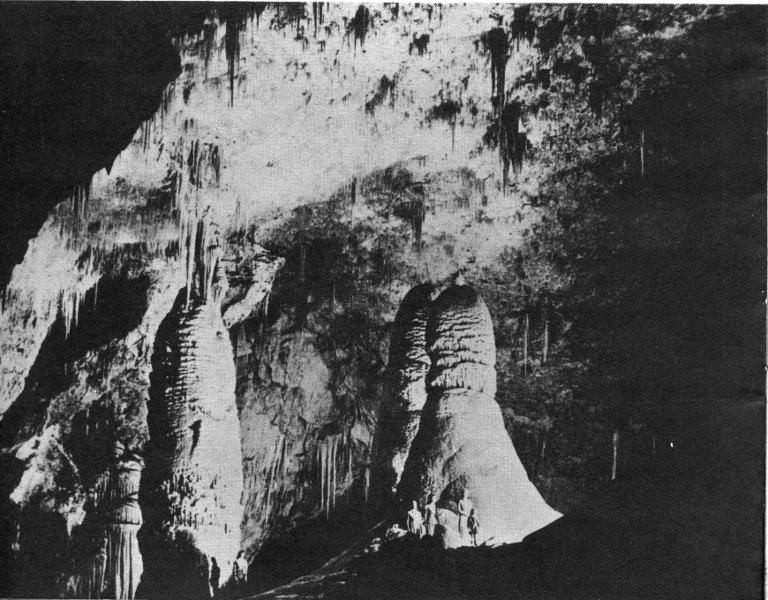
The Hall of Giants Section of the Big Room—Approximately 2,000 feet long and about 1,100 feet wide
But Jim White might as well have saved his breath. Convincing the gang at the ranch and camp was a hopeless task, and the Kid’s command of English was so inadequate that he could contribute little except “Si, si!” and nods of enthusiasm. That wasn’t enough. The story fell on unresponsive ears.
On the streets of Carlsbad, then called “Eddy”, just a few days after his fiery experience, Jim White met a friend who had once visited Mammoth Cave in Kentucky. The friend countered Jim’s story with the belief that there just couldn’t be a bigger cave than Mammoth! ... so before long, two heads bent over encyclopedias and reference books with pictures and information about caves. The more Jim White learned—the more pictures he saw—the more positive he became that the cave he had explored was larger and more beautiful than any cavern then on record! At the turn of the century, Jim White had talked “bats” and “cave” until word went ’round that both the bats and the cave were in Jim’s head!
Scenes in and near Carlsbad Caverns National Park
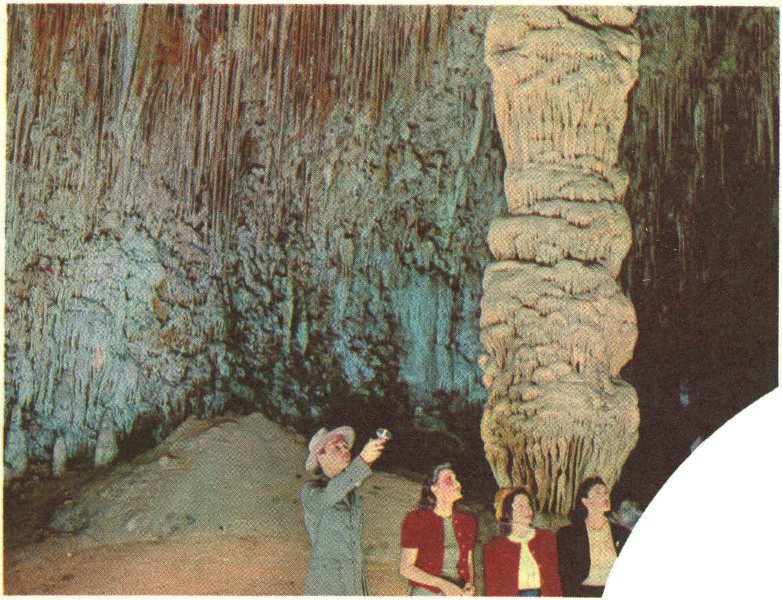
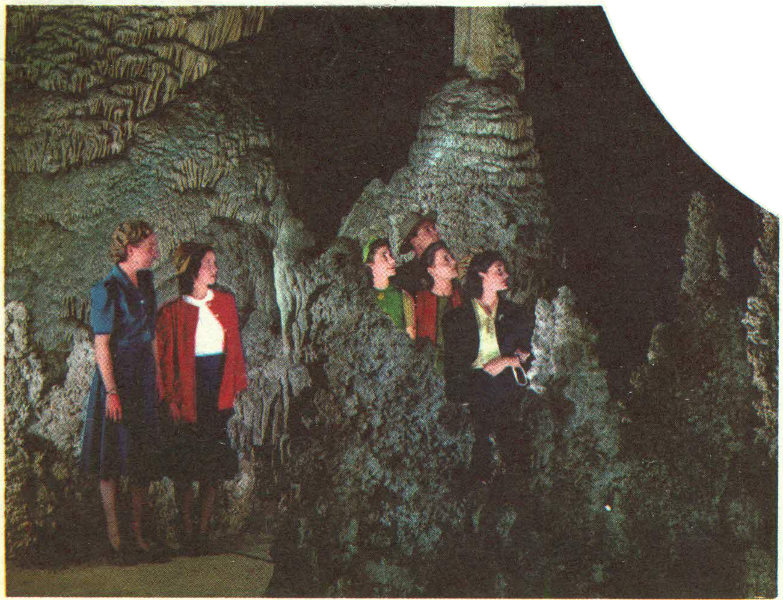
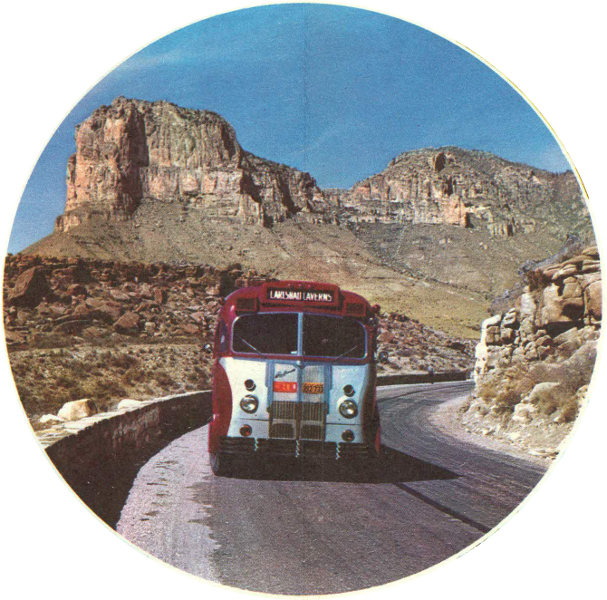
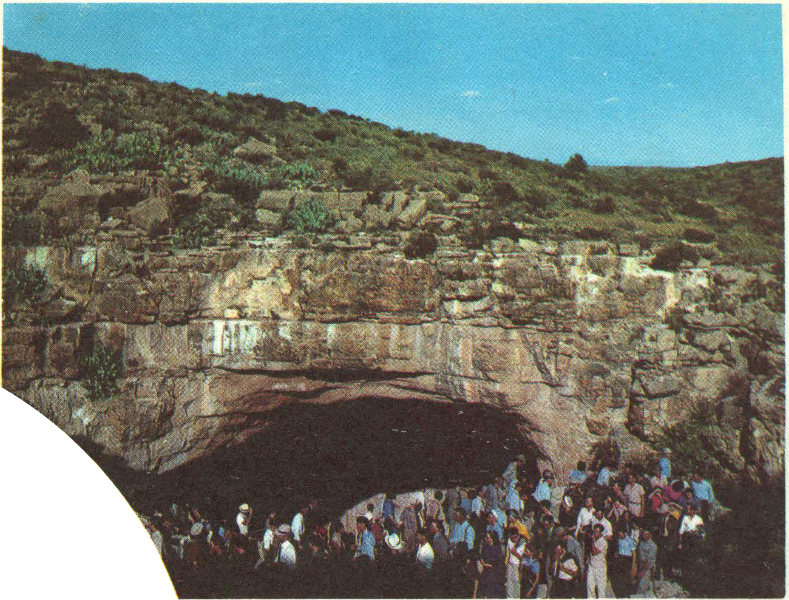
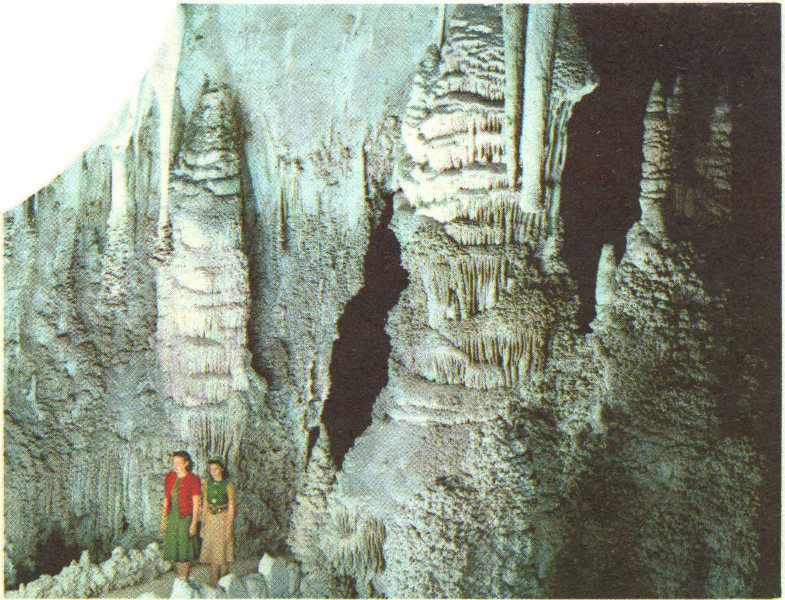
Jim White’s first descent into the cave was in 1901. During the next few years he was unable to convince anyone of the attractions of the cave sufficiently to have them pay much attention to its beauty. But as early as 1903 interest developed in the guano known to be there. In that year Abijah Long filed a placer mining claim to guano and other mineral rights for twenty acres around the entrance to the caverns. This claim is recorded in the Eddy County Mining Records. Again in 1908, and later in 1910 and 1912, other placer mining claims were filed on land in the vicinity of the cave entrance. This land was never patented. However, the land to the east, over the Bat Cave, belonged to the Santa Fe Railroad and was sold in 1905, and ownership of this forty acres changed hands a number of times before it was finally acquired by the government.
Jim continued to work on the ranch for awhile, but when the guano operations began, his interest in the cave induced him to go to work for the company removing the fertilizer. Although it is estimated that about a hundred thousand tons of guano were removed from the Bat Cave between 1903 and 1923, it was probably not a very profitable operation; for at least six different companies had a fling at it. Jim worked for all but one of them off and on, and never did any more than just make a bare living.
Through all these years Jim White made frequent efforts to convince someone—anyone who would listen—about the wonders he had seen beyond the cave entrance, beyond the rooms containing the guano. Despite his failure to win more than casual interest, whenever there was a lull in the guano business, he would take food and other supplies and explore more of the cave. In fact, Jim succeeded in getting some of the miners to explore the cave with him during their spare time, as is proven by the prevalence of names and dates (1904 to 1911) smudged on the ceilings, walls and rocks as far into the caverns as the King’s Palace.
One day came the thought that if he could get a photographer to make the trip with him, he could show photographic proof to the world of his now-favorite scene of adventure. His first attempt met with failure simply because the man who had the camera wanted a hundred dollars for the trip. Jim didn’t have a hundred dollars.
Along about 1920, economic conditions were mighty bad. Jim and Mrs. White were living in a shack near the cave entrance. Jim was always up at daylight, following the youthful custom long-ago established on the ranch. One morning, however, Jim didn’t rise with the dawn. For one of the few times in his married life, Mrs. White was up first.
She made coffee, then returned to the bedroom door somewhat alarmed, and asked:
“Jim, I’ve never known you to stay in bed so late ... are you sick?”
Jim laughed reassurance. “I’ve just been layin’ here since day-break, thinkin’. I’ve made up my mind I’m going to get out of this bed and start showing people that cave, whether they want to see it or not!”
“How are you going to do it?” Mrs. White inquired.
“Right now I don’t know,” Jim stated. “But when I get up, I’m going to start”.
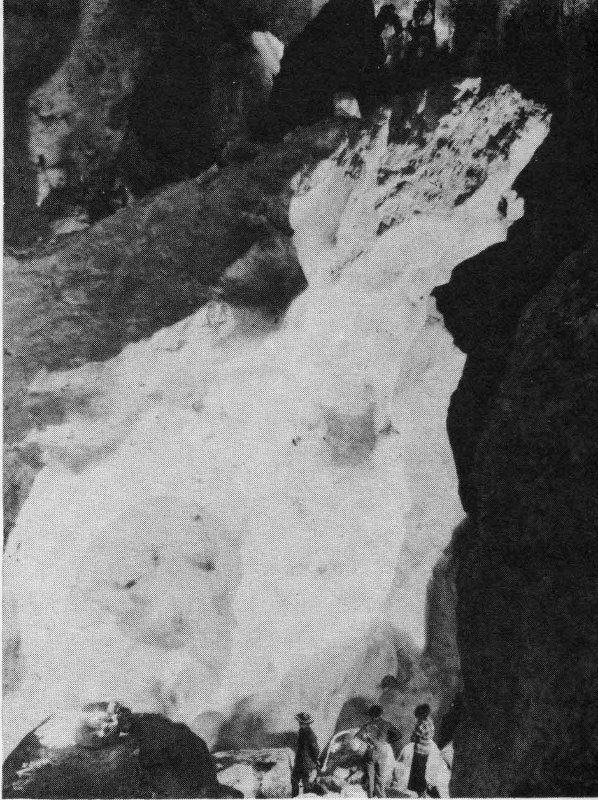
The Iceberg—One of the interesting features of the Caverns
Jim lay still a little longer. The idea came that if the world could be made to see the cave, trails and guard-rails ought to be built, to gain even a relative amount of safety and accessibility. Jim rose, dressed, ate breakfast and started. He began moving rocks and leveling passageways through the first chamber. At dangerous ledges he searched out cracks in the rocks, into which he drove discarded axles from old automobiles. From one of these to another, Jim strung galvanized wire to serve as hand-holds. Working alone most of the time, he seemed tirelessly ready for an endless task, constantly buoyed by the thought that he was building a pathway over which many others might travel, into the incredibly beautiful fairyland so far below the hot desert.
Strange how much a man’s vision and energy can drive him to achieve! Strange, too, that Jim White’s consuming purpose was to lure an apparently disinterested world to see what he had seen—perhaps in order to justify his years of insistence that the place did exist somewhere beyond his own imagination. The world simply had to see this magnificent spectacle into which he had first crawled.
Working in the cave those countless hours and continuing to explore until 17 he had visited most of the present known areas, Jim White felt his awesome appreciation translated into something akin to love. He wanted to display it proudly to other approving, comprehending eyes—and watch them light with awe and wonder. Jim was an unlettered man, as were most of his associates, and no written record of his findings was made.
At last two young men, crossing the country in an old jalopy pulled up at the cave and asked Jim if there was a chance to see it! Chance? Jim White would be delighted to show them through, he explained. One of them had a kodak. When the young fellow asked about flashlight powder, Jim told him about his effort to get a photographer to record a picture-story of the cave. At Jim’s suggestion that flashlight powder might be found in Carlsbad, the youths started back to town, offering to see if they could find a photographer who would make the trip, taking for his pay the right to distribute pictures. An early-morning start into the cave the next day was planned by Jim White and the first two persons from the outside world who ever expressed a desire to see into the underground palaces!
Any human being in Jim White’s place would have felt as he did when his first three guests—the two young men and Ray V. Davis, the photographer they brought back from Carlsbad—started that stroll down the ageless corridors! Hearing their gasps of appreciation was to Jim White an accolade! Seeing their eyes was to find his belated, yearned-after justification. Listening to them as they tried and failed to express what they felt showed Jim White that at least three other men in the world felt about the caverns somewhat as he did. He must even have enjoyed hearing photographer Davis complain because there was no more film, for Davis had used all of his two-dozen plates within the first enthusiastic mile!
When the twenty-four pictures were developed and prints came before the eyes of former doubters in town, Jim White was besieged by those who wanted to take the trip through the cave. Red Wheeler and Harry Stephens persuaded Jim to organize an excursion party for the tour, and so it was that another “original thirteen” came to be recorded in the centuries old history of Carlsbad Caverns. Wheeler and Stephens were two, photographer Davis made three. The others in the original party were Luther Perry, E. H. Weaver, Dan Lowenbrook, Homer Grabb, Coly Jones, J. R. Yates, J. B. Morris, John Nevenger, J. R. Owen and C. P. Pardue, all of Carlsbad. Superstition was relieved by the fourteenth member of the party—Jim White, now Guide!
In those days, it was an all-day trip across the thirty miles of prairie and mountain to the mouth of the cave. The party reached Jim’s shack late in the afternoon, ate the supper Mrs. White had waiting, then bunked early to rest for the all-day trek scheduled for daybreak. The first sightseers were lowered by two’s ... Jim White at the winch ... his passengers in the bucket used by the guano company to get down into the Bat Cave. Down they went into the black shaft which was the doorway to beauty.
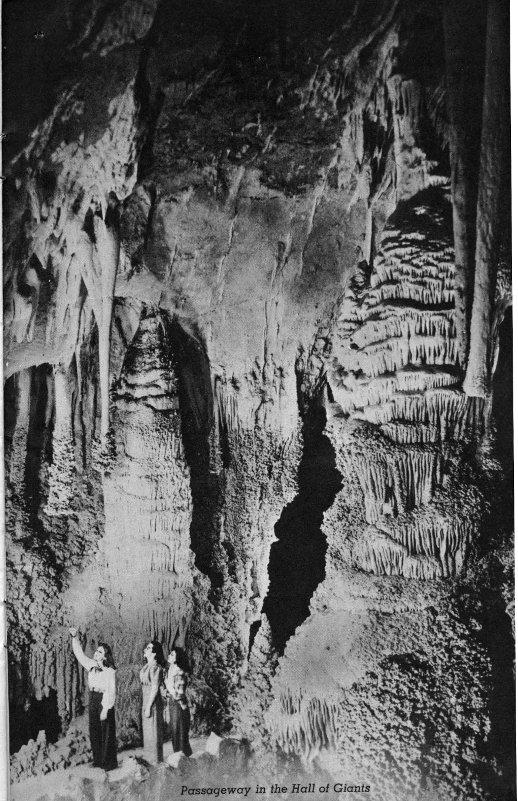
Passageway in the Hall of Giants
It never occurred to Jim White that he should charge admission to the cave, and when the party started back to town he refused to set a price. The guests insisted on paying something, if only for the food, for Mrs. White’s trouble in feeding and housing them, and Jim’s own trouble both in the shack and in the caverns. The discussion ended with each guest paying a dollar. The thirteen dollars Jim used to buy more materials—to carry his trail even deeper into the cave.
A few days later on the streets of Carlsbad, Jim was greeted by one of his “original thirteen” sightseers. “Jim, that cave of yours is the greatest sight of its kind you or I or anyone else ever saw. You should charge everybody you take through it, five dollars! Man, it’s worth it!”

The Scenic Drive Within Carlsbad Caverns National Park to the Caverns Entrance
Meantime, the thirteen had passed along the word until it seemed that everyone was begging to be taken through the cave. Jim was at last obliged 20 to fix a price of two dollars, since visitors to the then isolated spot had to be fed, and as the numbers increased, bunkhouses had to be built. As a moneymaker, Jim White’s Cave was not a success in those early days, since equipment and accommodations outran the income, even at two dollars per person for the guided tours. Then there were the days when Jim would greet some poor old farmer with a wife and bunch of kids. The family would want to take the trip through the Cavern, now beginning to achieve local fame, but who obviously could not afford that two-dollars-each admission price. Since it would seem unfair to admit them without charge while making others pay, Jim White would simply declare that day as “A Free Day”.

Graceful, Sheer Draperies of Pure Crystalline Cave Rock
Jim White, the Guide, had the pleasure of taking the very poor and the very rich through the fairyland beneath the New Mexico desert. Jim White had fought for it so long he had become sentimental about the great Caverns.
In time people throughout the world learned of the fantastic beauty of the Caverns, and good roads became the pathways for awe-stricken thousands who arrived to gaze at what no man could explain completely—miraculous caverns that defy mankind’s vocabulary to describe.
By 1922 the scenic and scientific values of the caverns were of local and gradually expanding importance. Newspaper men and writers would always receive complimentary tours from Jim White, who realized that printed stories, in whatever publications, would have untold advertising value. The crowd read of the Caverns at Carlsbad—they heard of them from friends—and they gathered in increasing numbers to be lowered in the old guano-bucket. Jim White lifted nervous spinsters across narrow ledges, and pulled fat ladies up steep inclines. When his parties reached particularly dangerous spots, Jim’s body was always in a position to shield their eyes from the perils, so no one 21 would become frightened, and make a misstep. In spite of the rickety and exciting descent in the old bucket, and the inadequacy of the trails, there was never an accident ... never so much as a broken arm or leg. There were some hairbreadth escapes, with Jim White’s firm hand grasping someone by the seat of the pants to prevent a sudden plunge into a pit.
News of the wonderful cave out on the desert southwest of Carlsbad finally reached Washington and the authorities decided to check up on it. In April, 1923, the General Land Office in Washington sent Mr. Robert Holley, a mineral examiner to make a survey. Jim keenly felt Mr. Holley’s original scepticism when the newcomer said: “We didn’t feel as though this cave was of much importance, but the Department thought I’d better run down and measure it, so they could know if it is big enough for them to consider”. Jim grinned and said little. The next morning Jim White lowered Mr. Holley and his instruments into the cavern for the first time. It took the government man over a month to finish his very complete and accurate work and report. Scepticism turned to enthusiasm, as is witnessed by the opening paragraph of his survey-report in which Mr. Holley stated:
“I enter upon the task of compiling this report with a feeling of temerity, as I am wholly conscious of the feebleness of my efforts to convey in words the deep conflicting emotions, the feeling of fear and awe, and a desire for an inspired understanding of the Divine Creator’s work which presents to the human eye such a complex aggregate of natural wonders in such a space”. In concluding, Mr. Holley said: “... it appears that this cave is of such wonderful character as to be worthy to be established as a national monument....”.
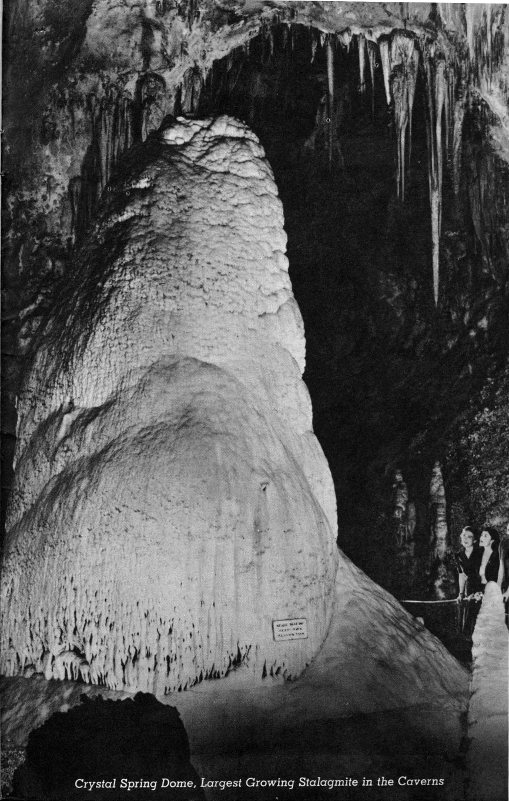
Crystal Spring Dome, Largest Growing Stalagmite in the Caverns
Shortly after the favorable Holley survey was completed, Mr. Richard F. Burges, a prominent El Paso attorney, made a visit to the caverns and was taken through by Jim White. He, too, was greatly impressed with the scenic beauties and the majestic grandeur found here and he began strenuously to exert every effort to bring attention to the cave. He had caught Jim’s enthusiasm for the project and Mr. Burges’ considerable influence, both locally and nationally, soon had effect. He was instrumental in obtaining the 1923 studies of Dr. Willis T. Lee, government geologist. Dr. Lee returned the following year heading an exploration party whose finding, published in the National Geographic Magazine, brought the caverns world-wide attention. Of importance to the realization of Jim White’s dream was “Major” Burges’ work in acquainting members of Congress with the beauty and possibilities of the caverns.
Jim White was contacted by the Government for his suggestion as to how much land should be reserved for the purpose.
Jim White, in later discussing the Land Office request for information, would say, wryly, “There are several other large caves near Carlsbad Caverns, and my suggestion was to include all the land covering those caves. A lot of times I’ve wished that I’d held out one cave for myself.”
Resulting from the Holley report and Major Burges’ efforts, and culminating Jim White’s two-decade battle against indifference and unbelief, came the decision to make the cave area a National Monument. President Coolidge’s proclamation of October 25th, 1923, created the Carlsbad Cave National Monument.
Jim White’s application for the position of custodian of the new National Monument had the support of the Carlsbad Chamber of Commerce, and it was accepted. But Jim was informed there was no salary attached to that job; so then he filed his application for the job of Chief Ranger, which carried a salary. That position he promptly received.
One day shortly after he’d been made Chief Ranger, Jim White had a party in the cave. He pointed to the main entrance high above and said to a visitor:
“Lowering people in the old bucket down to the Bat Cave is too slow. Some of these days I’m going to build a stairway from where we are sitting, clear up through that main opening.”
Through the kindness, generosity and foresight of several Carlsbad citizens, Jim White’s stairway was built a few months later. More than a hundred 24 thousand people used it during the next seven years, until the National Park Service completed the trail that slopes gently down the side of the wall ... a means of entrance far better than the old stairway.
Dr. Vernon Bailey was sent to the caverns to do the biological survey on the bats. Seeing the strange mammals hanging aloft in sleep, Dr. Bailey observed that there couldn’t be more than a thousand in the whole cave. Jim White told him to stick around and watch them fly. Bailey did. In his book called “Animal Life of Carlsbad Cavern”, he used the numerical description “Three million” when he wrote of that first bat-flight which he watched.
In 1930, the caverns Jim White had explored were redesignated. On May 14th of that year an Act of Congress established the Carlsbad Caverns National Park, with a resident Superintendent in charge, assisted by a force of trained rangers, engineers and electricians.
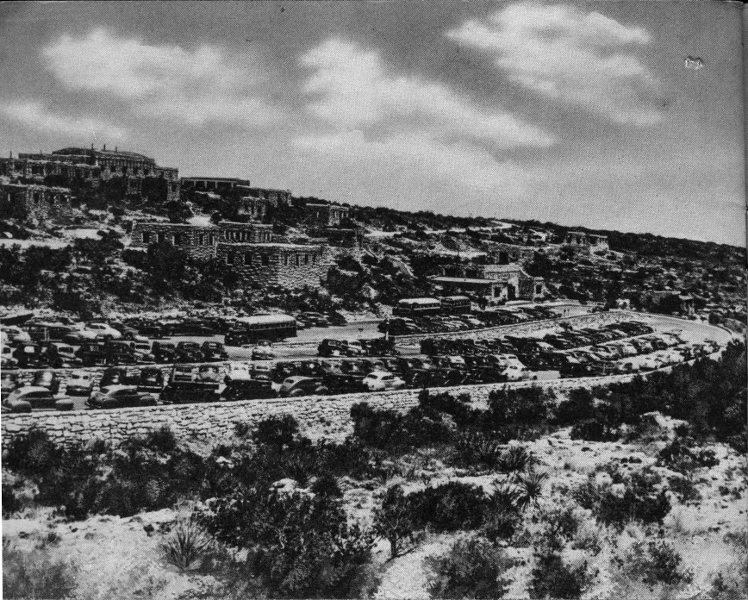
Government Buildings and Parking Terraces Adjacent to the Entrance to Caverns
By 1927 Jim White had begun to see his fondest dreams materialize—those dreams about showing to the world what was to become Carlsbad Caverns National Park. People from literally all over the world were hearing of it, and were arriving in crowds.
Early that summer the Government appointed a resident custodian to administer the Monument. During the next two years tourist facilities, equipment and improvements moved so fast it was hard for Jim to keep up with the progress. Approximately three miles of trails were completed in compliance with modern engineering standards. Diesel engines and huge generators were installed, and the soft glow from hundreds of electric lights replaced Jim White’s crude, home-made kerosene torches. A lunch room was equipped in the depths of the cave—not far from the spot where the Kid set Jim afire one day long ago.
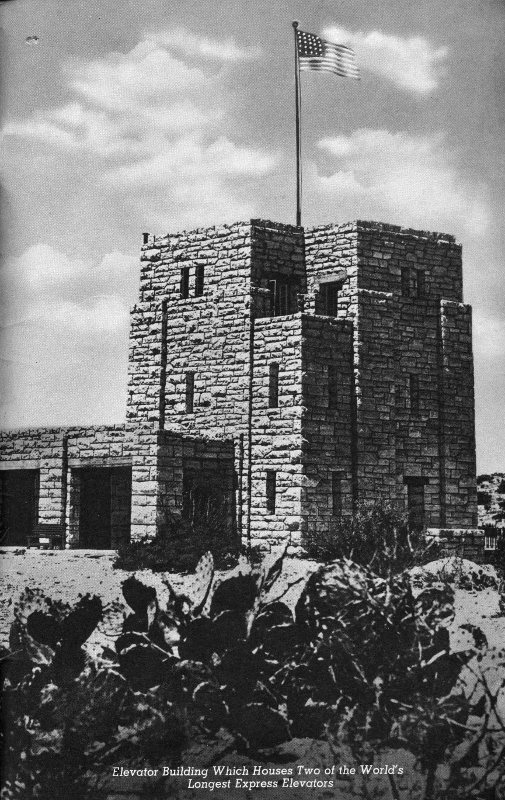
Elevator Building Which Houses Two of the World’s Longest Express Elevators
The United States Government charges a guide fee but have appropriated large sums for developing the caverns along progressive lines.
Jim White said it this way: “It’s like a pleasant end to a long dream. I like the modernizing, even letting the world see the cavern with all the conveniences and comforts you might find in a city hotel—electric lights—trails smooth as floors—food and steaming coffee when you’re hungry—running water and telephones clear back to the end—even modern elevators to carry you up if you get tired walking.
“In the spring of 1929 I could see that the job of Chief Ranger was getting too complicated for me, with my limited education; so I resigned my position.
“Even a cave millions of years old can go too modern, too efficient ... and out-grow a common old cowboy”.
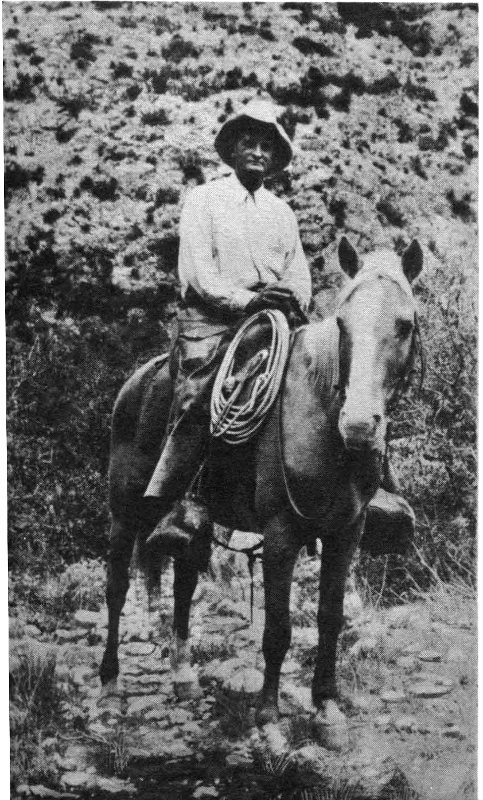
Jim White, the Cowboy

“... and He hath shewed His people the power of His works.” Psalm 111

U. S. Highway 62 near Carlsbad Passes Close to El Capitan, the Point of the Rugged Guadalupe Mountains
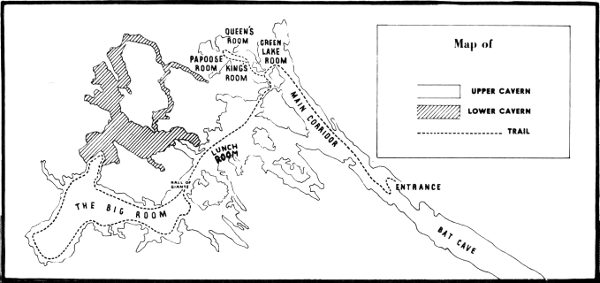
A GENERALIZED MAP OF CARLSBAD CAVERNS
High-resolution Map

This drawing represents a trip through Carlsbad Caverns, rather than an accurate map. It is impossible to draw an accurate cross-section of the caverns since some of the rooms are behind others. The sketch represents approximately seven miles of well-lighted trails through the caverns. Many additional miles have been explored, but are not open to the public. Temperature in the caverns remains at a constant 56 degrees throughout the year.
